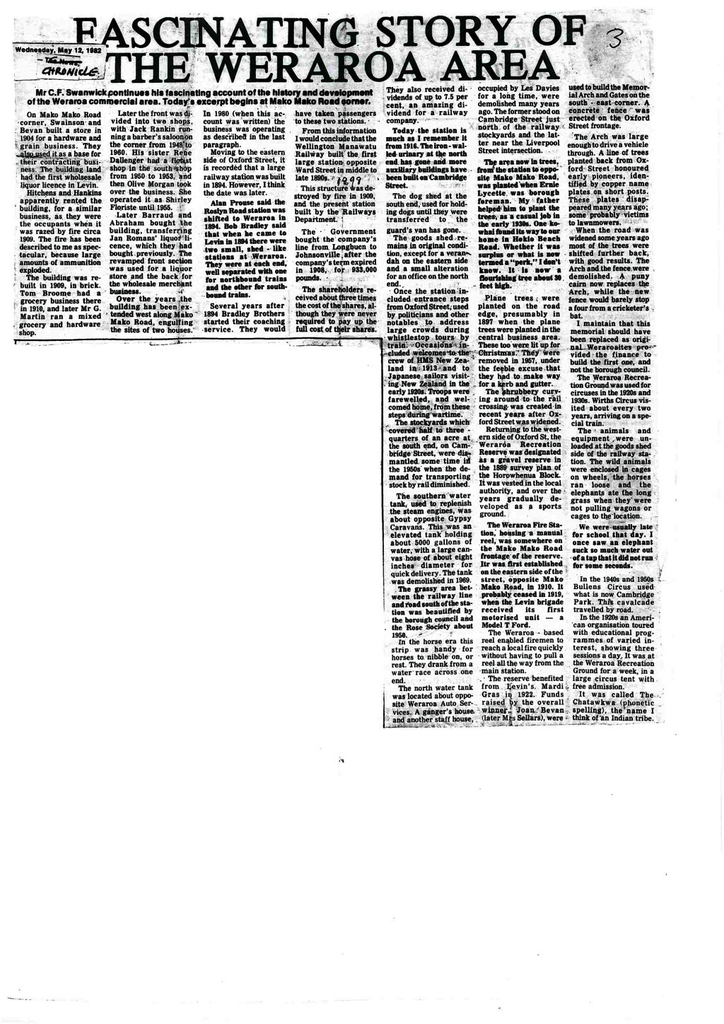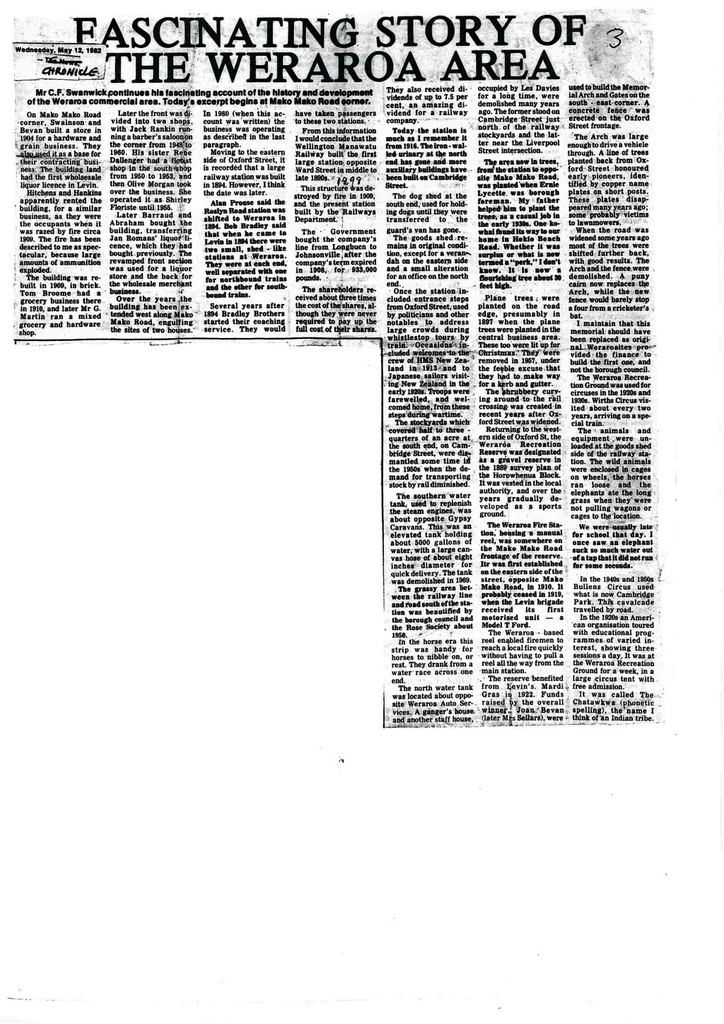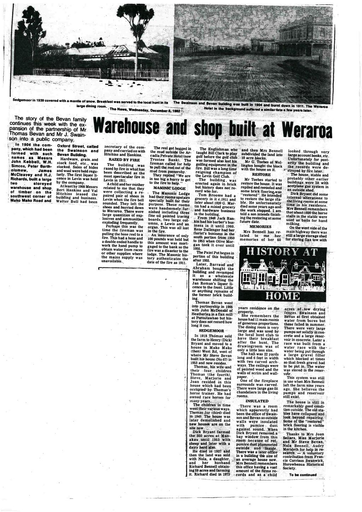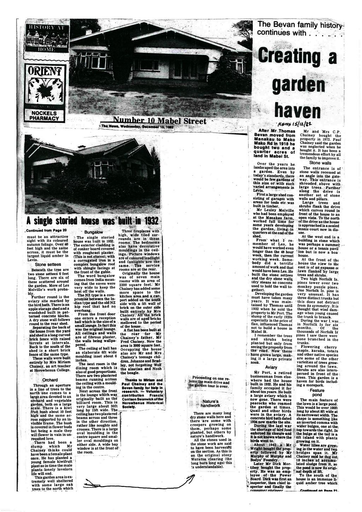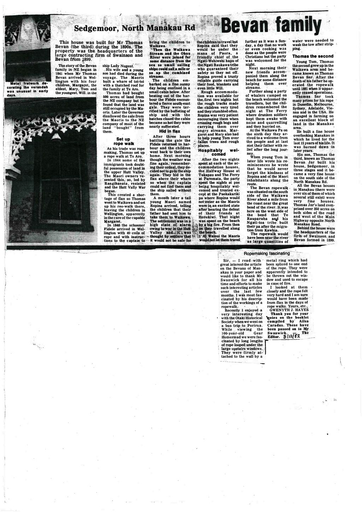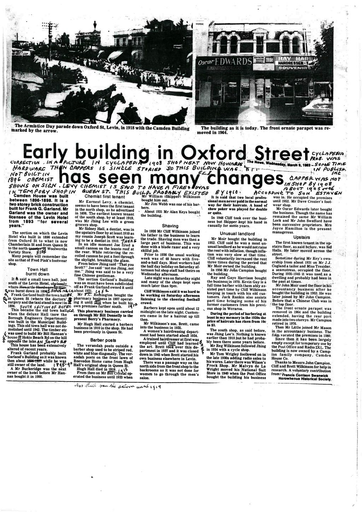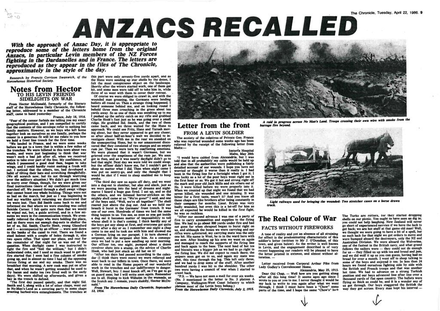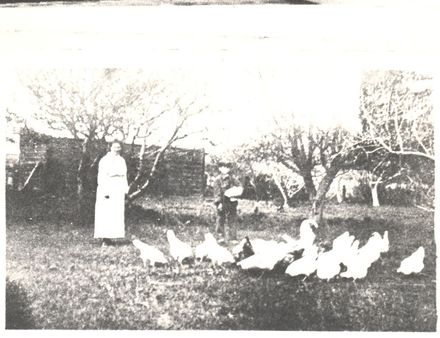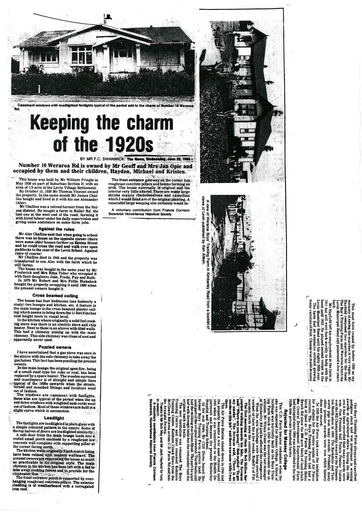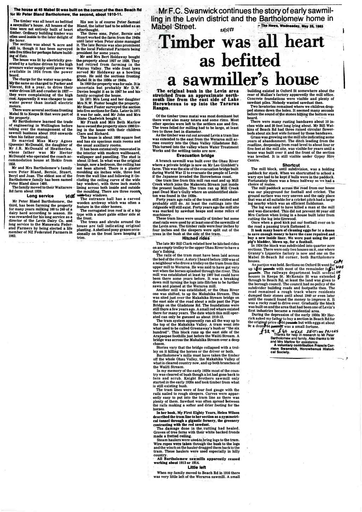Fascinating Story of The Weraroa Area
- Description
On Mako Mako Road corner, Swainson and Bevan built a store in 1904 for a hardware and grain business. They also used it as a base for their contracting business. The building land had the first wholesale liquor licence in Levin.
Hitchens and Hankins apparently rented the building, for a similar business, as they were the occupants when it was razed by fire circa 1909. The fire has been described to me as spectacular, because large amounts of ammunition exploded.
The building was rebuilt in 1909, in brick. Tom Broome had a grocery business there in 1910, and later Mr G. Martin ran a mixed grocery and hardware shop.
Later the front was divided into two shops, with Jack Rankin running a barber’s saloon on the corner from 1948 to 1960. His sister Rene Dallenger had a florist shop in the south shop from 1950 to 1953, and then Olive Morgan took over the business. She operated it as Shirley Floriste until 1955.
Later Barraud and Abraham bought the building, transferring Jan Romans’ liquor licence, which they had bought previously. The revamped front section was used for a liquor store and the back for the wholesale merchant business.
Over the years, the building has been extended west along Mako Mako Road, engulfing the sites of two houses. In 1980 (when this account was written) the business was operating as described in the last paragraph.
Moving to the eastern side of Oxford Street, it is recorded that a large railway station was built in 1894. However, I think the date was later.
Alan Prouse said the Roslyn Road station was shifted to Weraroa in 1894. Bob Bradley said that when he came to Levin in 1894 there were two small shed-like stations at Weraroa. They were at each end, well separated with one for northbound trains and the other for southbound trains.
Several years after 1894 Bradley Brothers started their coaching service. They would have taken passengers to these two stations.
From this information, I would conclude that the Wellington Manawatu Railway built the first large station opposite Ward Street in middle to late 1890s.
This structure was destroyed by fire in 1898 and the present station built by the Railways Department.
The Government bought the company’s line from Longburn to Johnsonville after the company’s term expired in 1908, for £933,000.
The shareholders received about three times the cost of the shares, although they were never required to pay up the full cost of their shares. They also received dividends of up to 7.5%, an amazing dividend for a railway company.
Today the station is much as I remember it from 1916. The iron walled urinary at the north end has gone and more auxiliary buildings have been built on Cambridge Street.
The dog shed at the south end, used for holding dogs until they were transferred to the guard’s van, has gone.
The goods shed remains in original condition, except for a verandah on the eastern side and a small alteration for an office on the north end.
Once the station included entrance steps from Oxford Street, used by politicians and other notables to address large crowds during whistlestop tours by train. Occasions included welcomes to the crew of HMS New Zealand in 1913 and to Japanese sailors visiting New Zealand in the early 1920s. Troops were farewelled, and welcomed home, from these steps during wartime.
The stockyards which covered half to three-quarters of an acre at the south end, on Cambridge Street, were dismantled some time in the 1950s when the demand for transporting stock by rail diminished.
The southern water tank, used to replenish the steam engines, was about opposite Gypsy Caravans. This was an elevated tank holding about 5000 gallons of water, with a large canvas hose of about eight inches diameter for quick delivery. The tank was demolished in 1969.
The grassy area between the railway line and road south of the station was beautified by the borough council and the Rose Society about 1950.
In the horse era this strip was handy for horses to nibble on, or rest. They drank from a water race across one end.
The north water tank was located about opposite Weraroa Auto Services. A ganger’s house and another staff house, occupied by Les Davies for a long time, were demolished many years ago. The former stood on Cambridge Street, just north of the railway stockyards and the latter near the Liverpool Street intersection.
The area now in trees, from the station to opposite Mako Mako Road, was planted when Ernie Lycette was borough foreman. My father helped him to plant the trees, as a casual job in the early 1930s. One kowhai found its way to our home in Hokio Beach Road. Whether it was surplus or what is now termed a “perk,” I don’t know. It is now a flourishing tree about 30 feet high.
Plane trees were planted on the road edge, presumably in 1897 when the plane trees were planted in the central business area. These, too, were lit up for Christmas. They were removed in 1957, under the feeble excuse that they had to make way for a kerb and gutter.
The shrubbery curving around was created in recent years after Oxford Street was widened.
Returning to the western side of Oxford Street, the Weraroa Recreation Reserve was designated as a gravel reserve in the 1889 survey plan of the Horowhenua Block. It was vested in the local authority, and over the years gradually developed as a sports ground.
The Weraroa Fire Station, housing a manual reel, was somewhere on the Mako Mako Road frontage of the reserve. It was first established on the eastern side of the street, opposite Mako Mako Road, in 1910. It probably ceased in 1919, when the Levin brigade received its first motorised unit – a Model T Ford.
The Weraroa- based reel enabled firemen to reach a local fire quickly, without having to pull a reel all the way from the main station.
The reserve benefited from Levin’s Mardi Gras in 1922. Funds raised by the overall winner, Joan Bevan (later Mrs Sellars), were used to build the Memorial Arch and Gates on the south-east corner. A concrete fence was erected on the Oxford Street frontage.
The Arch was large enough to drive a vehicle through. A line of trees planted back from Oxford Street honoured early pioneers, identified by copper name plates on short posts. The plates disappeared many years ago; some probably victims to lawnmowers.
When the road was widened some years ago most of the trees were shifted further back, with good results. The Arch and a fence were demolished. A puny cairn now replaces the Arch, while the new fence would barely stop a four from a cricketer’s bat.
I maintain that this memorial should have been replaced as original Weraroaites provided the finance to build the first one, and not the borough council.
The Weraroa Recreation Ground was used for circuses in the 1920s and 1930s. Wirths Circus visited about every two years, arriving on a special train.
The animals and equipment were unloaded at the goods shed side of the railway station. The wild animals were enclosed in cages on wheels, the horses ran loose and the elephants ate the long grass when they were not pulling wagons or cages to the location.
We were usually late for school that day. I once saw an elephant suck so much water out of a tap that it did not run for some seconds.
In the 1940s and 1950s Bullens Circus used what is now Cambridge Park. This cavalcade travelled by road.
In the 1920s an American organisation toured with educational programmes of varied interest, showing three sessions a day. It was at the Weraroa Recreation Ground for a week, in a large circus tent with free admission.
It was called The Chatawkwa (phonetic spelling), the name I think of an Indian tribe.
Identification
- Date
- May 12, 1982
Taxonomy
- Community Tags

